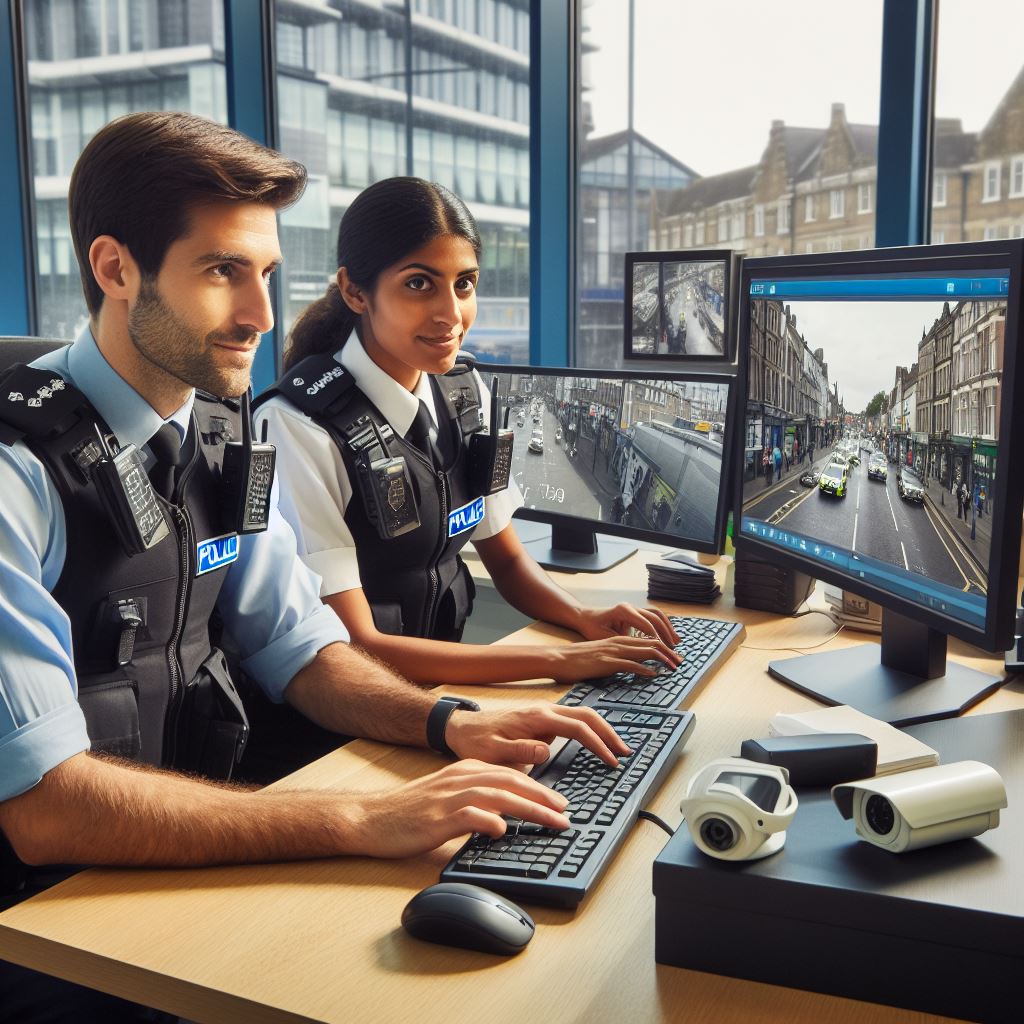Introduction
The UK police force stands as a vital institution, adapting to the complexities of contemporary society.
With rapid technological advancements, modern policing relies heavily on innovative tools and systems.
From its historical origins, the UK police force has evolved to address diverse challenges. It plays a central role in maintaining law and order, ensuring public safety, and upholding justice.
The importance of technology in modern policing cannot be overstated, transforming traditional practices.
Also, digital advancements enable real-time communication, improving coordination among law enforcement agencies.
Technology has facilitated data-driven decision-making, allowing police to analyze patterns, predict trends, and deploy resources strategically.
The use of CCTV systems, drones, and advanced surveillance tools has aided in monitoring public spaces and preventing criminal activities.
While technology offers immense benefits, addressing privacy concerns and ensuring ethical use are critical.
In essence, the synergy between the UK police force and technology underscores the commitment to effective law enforcement.
Embracing innovations ensures adaptability to dynamic challenges, ultimately safeguarding communities and fostering a safer society.
Historical Background of Policing in the UK
A. Evolution of Policing Methods
- Policing in the UK has evolved significantly over the years, adapting to changing societal needs.
- During the medieval period, law enforcement was decentralized, with individual communities responsible for maintaining order.
- The Metropolitan Police Act of 1829 established the first centralized police force in London, led by Sir Robert Peel.
- Peel’s police force, often referred to as “Bobbies,” aimed to prevent crimes rather than just reacting to them.
- Uniformed patrols, street lighting, and crime prevention strategies were introduced to enhance public safety.
- The use of technology in policing began with the introduction of the telegraph system in the late 19th century.
- As technology continued to advance, police started using bicycles, cars, and motorcycles for patrolling.
- With the rise of radio communication in the early 20th century, officers could stay in constant contact with headquarters.
- The availability of new technologies such as fingerprinting and early forms of forensic science revolutionized crime investigations.
B. Traditional Challenges Faced by the Police Force
Historically, the police force in the UK has faced numerous challenges in maintaining law and order.
- Policing urban areas, with their high population densities and diverse communities, has always presented unique challenges.
- Riots, protests, and civil disturbances have tested police abilities to manage crowd control and maintain public safety.
- Combating organized crime, drug trafficking, and terrorism has been an ongoing challenge for law enforcement agencies.
- Policing rural areas, with their vast landscapes and limited resources, has its own set of challenges.
- Geographical barriers can hinder officer response times and make it difficult to effectively cover large territories.
- Dealing with domestic violence cases requires sensitive handling to protect victims and hold offenders accountable.
- Respecting human rights and balancing public safety with individual liberties has always been a delicate task for the police.
- Ensuring police accountability and preventing corruption are continual concerns for maintaining public trust.
- The rapid advancements in technology pose new challenges related to cybersecurity and data protection.
In summary, the evolution of policing methods in the UK has brought significant improvements to law enforcement.
From the establishment of the centralized police force in London to the adoption of new technologies, the police have strived to adapt to changing societal needs.
However, traditional challenges such as managing urban and rural areas, combating organized crime, and balancing public safety with individual rights persist.
Additionally, the rapid pace of technological advancement poses new challenges that need to be addressed.
Personalized UK Career Consulting
Receive tailored career guidance designed just for you. Get actionable steps and expert support to boost your career in 1-3 days. Take control of your career now.
Get StartedThe next section will explore the role of technology in modern UK policing and how it addresses some of these challenges.
Read: The Evolution of Policing in the United Kingdom
The Role of Technology in Modern Policing
Technology plays a crucial role in modern policing, revolutionizing the way law enforcement agencies operate and ensuring more effective crime prevention and detection.
This section delves into the various aspects of technology that have transformed policing in the UK.
A. Advancements in Communication Technology
1. Introduction of radios and mobile devices
The introduction of radios and mobile devices has significantly improved communication within and between police departments.
In the past, officers had to rely on traditional methods of communication, such as landlines or police call boxes, which were often time-consuming and inefficient.
The use of radios and mobile devices allows for instant and direct communication between officers, enabling faster response times and seamless coordination during operations.
2. Use of data and voice encryption for secure communications
To ensure secure communications and prevent unauthorized access to sensitive information, data and voice encryption techniques are employed.
Encryption technology ensures that only authorized personnel can access and understand the transmitted data.
This safeguard is vital in maintaining the confidentiality and integrity of law enforcement operations.
B. Enhanced Surveillance and Crime Prevention
1. Development of CCTV systems
The development and widespread use of Closed-Circuit Television (CCTV) systems have revolutionized surveillance capabilities.
These systems provide real-time monitoring and recording of public areas, helping to deter criminals and capture evidence of criminal activities.
CCTV footage has become a valuable investigative tool, often leading to the identification and apprehension of suspects.
2. Use of facial recognition technology
Facial recognition technology has also gained prominence in modern policing.
Your Dream Job Starts with a Perfect CV
Get a tailored CV and cover letter that captures your unique strengths and stands out in your industry. Let us help you make an unforgettable first impression.
Get StartedBy analyzing facial features captured on CCTV or from other sources, law enforcement agencies can quickly identify individuals of interest.
This technology has proven effective in locating wanted criminals and enhancing public safety by identifying potential threats in crowded locations.
C. Forensic Technology and Evidence Analysis
1. DNA profiling and fingerprint identification
Technology has significantly advanced forensic science, allowing for more accurate and efficient evidence analysis.
DNA profiling and fingerprint identification are two prominent examples of these advancements.
DNA profiling has revolutionized criminal investigations, providing indisputable evidence linking suspects to crime scenes.
Fingerprint identification, on the other hand, remains a fundamental method for establishing personal identity and is extensively used in solving crimes.
2. Sophisticated tools for digital forensics
- Digital forensics, another important area of forensic technology, deals with the recovering and analyzing of digital evidence.
- Law enforcement agencies now have access to sophisticated tools to retrieve data from computers, smartphones, and other digital devices.
- This enables investigators to uncover critical evidence, such as emails, chat logs, and deleted files, that can help solve complex cases.
Basically, technology plays a vital role in modern UK policing, enhancing communication, surveillance, and forensic capabilities.
The advancements in communication technology have improved operational efficiency and enabled secure law enforcement communications.
Enhanced surveillance tools like CCTV systems and facial recognition technology have significantly enhanced crime prevention and investigation.
Furthermore, forensic technology, including DNA profiling and digital forensics, has revolutionized evidence analysis and strengthened the criminal justice system.
Embracing technology is essential for law enforcement agencies to adapt and effectively combat modern-day threats.
Read: Career Progression Paths for UK Police Officers

Technology-Driven Approaches to Crime Investigation
In modern-day UK policing, technology plays a pivotal role in crime investigation.
It enables law enforcement agencies to adopt proactive approaches by utilizing big data, analytics, and cybercrime prevention methods.
Optimize Your LinkedIn for Success
Boost your LinkedIn profile with a professional bio, keyword-rich headline, and strategic recommendations that attract recruiters. Stand out from the crowd and get noticed.
Optimize NowThis section delves into the various technology-driven strategies implemented by the police force.
A. Use of big data and analytics
1. Predictive policing to anticipate crime patterns
Utilizing vast amounts of data, law enforcement can identify patterns and trends in criminal activities.
By analyzing historical crime data, predictive models are developed to forecast potential incidents.
These models enable police to deploy resources strategically and prevent crimes before they occur.
Predictive policing improves efficiency and resource allocation, making law enforcement more effective in reducing crime rates.
2. Data-driven decision-making for resource allocation
With the help of big data and advanced analytics, police can make informed decisions regarding resource allocation.
By analyzing crime data, police departments can identify high-crime areas and times, directing their efforts appropriately.
This data-driven approach ensures that police resources are efficiently distributed, maximizing their impact on crime prevention and detection.
It allows for targeted interventions, leading to better outcomes in crime investigation.
B. Cybercrime and digital policing
1. Addressing online fraud and identity theft
The rise of the digital age has brought new challenges to law enforcement, particularly in combating online fraud and identity theft.
Technology enables police to investigate and tackle these crimes effectively.
Advanced software tools and algorithms help in detecting fraudulent online activities and protecting individuals from identity theft.
Cooperation with financial institutions and online platforms is essential in tracing and apprehending offenders involved in cybercrime.
2. Tracking and apprehending cybercriminals
- In the digital realm, criminals exploit technology to carry out illegal activities.
- Policing agencies respond by leveraging technological advancements to track and apprehend cybercriminals.
- Specialized units equipped with cutting-edge tools and expertise play a crucial role in investigating cybercrimes.
- Collaboration with international agencies is crucial to combat cross-border cybercriminal networks.
- Continuous training and development are necessary to keep pace with rapidly evolving cyber threats.
Overall, technology-driven approaches in crime investigation have revolutionized modern UK policing.
The utilization of big data and analytics allows for predictive policing and informed decision-making, leading to efficient allocation of resources.
Moreover, addressing cybercrime and digital policing has become a top priority for law enforcement agencies, with efforts focused on combating online fraud, identity theft, and tracking cybercriminals.
Embracing technology and staying adaptable to emerging trends remain critical for effective crime investigation in the UK.
Read: How UK Police Handle Major Events & Crises
You Might Also Like: The Role of Internships in UK Political Careers
Gain More Insights: Pension Schemes for UK Gov Officers
Challenges and Limitations of Technology in Policing
Technology has undoubtedly revolutionized modern policing in the United Kingdom, enabling law enforcement agencies to tackle crime more efficiently and effectively.
However, along with its numerous benefits, there are also several challenges and limitations that arise when employing technology in policing.
A. Ethical and Privacy Concerns
1. Balancing security needs with individual privacy rights
While technology enhances surveillance capabilities, it raises concerns about potential violations of individuals’ right to privacy.
Striking a balance between ensuring public safety and respecting civil liberties is a delicate task.
2. Potential misuse of surveillance technologies
The emergence of advanced surveillance technologies, such as facial recognition and data analytics, raises ethical concerns regarding their potential misuse by authorities.
Safeguards and regulations must be in place to prevent abuse and protect citizens’ rights.
B. Training and Resources
1. Keeping up with rapidly evolving technologies
Law enforcement personnel face the challenge of staying updated with the constantly evolving landscape of technology.
Keeping pace with emerging tools and techniques requires continuous training and skill development to effectively leverage these advancements.
2. Allocation of funds for technology upgrades and training
- Investing in cutting-edge technology and providing comprehensive training programs for law enforcement officers incur significant costs.
- Police departments must prioritize budgets to ensure sufficient resources are allocated for technology upgrades and training initiatives.
As technology continues to advance, further challenges and limitations may arise, necessitating ongoing evaluation and adaptation within the policing domain.
It is crucial for law enforcement agencies to actively address these issues to effectively leverage technology while maintaining public trust and upholding ethical standards.
Current and Future Initiatives in UK Policing Technology
Policing in the UK is at the forefront of technological advancements, continually adapting to enhance efficiency and effectiveness.
A. Collaboration with Technology Firms and Research Institutions
Police forces actively seek partnerships with technology firms and research institutions to stay at the forefront of innovation.
- Collaborations facilitate the development and implementation of state-of-the-art technologies in policing.
- Engagement with research institutions allows agencies to benefit from academic expertise and cutting-edge advancements.
- The synergy between law enforcement and technology experts ensures a holistic approach to addressing evolving challenges.
B. Embracing Artificial Intelligence and Machine Learning
The integration of artificial intelligence and machine learning has become a cornerstone in the evolution of policing.
- AI algorithms analyze vast datasets, providing insights into crime patterns and trends.
- Predictive policing, powered by machine learning, enables proactive measures to prevent criminal activities.
- Continuous advancements in AI enhance the efficiency and effectiveness of law enforcement operations.
C. Experimentation with Drones and Autonomous Vehicles
The utilization of drones and autonomous vehicles marks a significant stride toward technological modernization in policing.
- Drones offer aerial surveillance, aiding in monitoring large areas, tracking suspects, and responding to emergencies.
- Autonomous vehicles, under experimental use, promise enhanced mobility and resource deployment.
- These technologies represent a shift toward a more dynamic and responsive policing infrastructure.
In short, current and future initiatives in UK policing technology reflect a commitment to leveraging innovation for public safety.
Read: Balancing Work-Life as a UK Police Officer
Gain More Insights: Diversity in UK Local Government Offices
Conclusion
Technology has revolutionized policing in the UK, aiding in investigations, crime prevention, and public safety.
Advanced surveillance systems, data analysis tools, and communication devices have significantly improved operational efficiency.
Real-time information sharing and collaboration between different law enforcement agencies have become easier with technology.
Artificial intelligence and machine learning algorithms have enhanced predictive policing and risk assessment.
Continued investment in technology is crucial for UK police forces to stay ahead of evolving crimes and criminals.
Adapting to new technologies can be challenging, requiring extensive training and change management processes.
Data security and privacy concerns need to be addressed to ensure trust and maintain public confidence in technology-enabled policing.
Integrating different technological solutions and systems into a seamless, unified framework is essential for maximum effectiveness.
Policing strategies must evolve alongside technology to keep up with the changing nature of crime.
In the end, technology plays a vital role in modern UK policing, offering numerous benefits and opportunities.
However, harnessing its full potential requires ongoing investment, training, and addressing challenges related to data security and integration.
By embracing technology effectively, UK police forces can enhance their capabilities, improve public safety, and stay one step ahead in the fight against crime.




